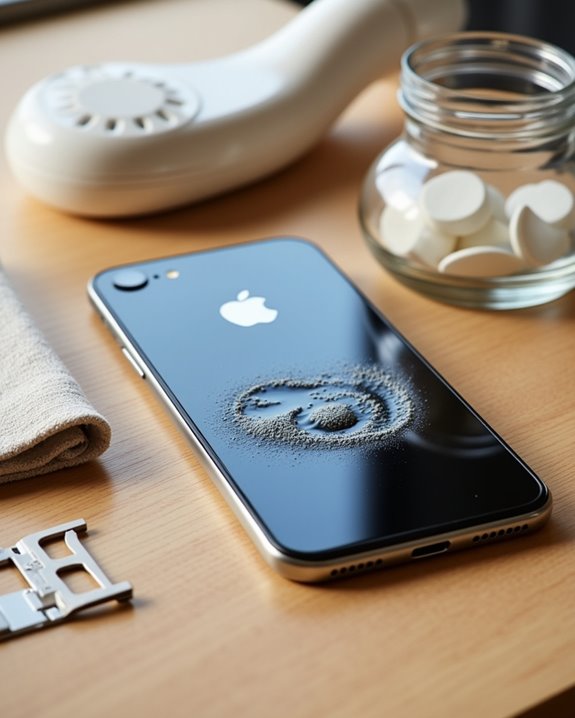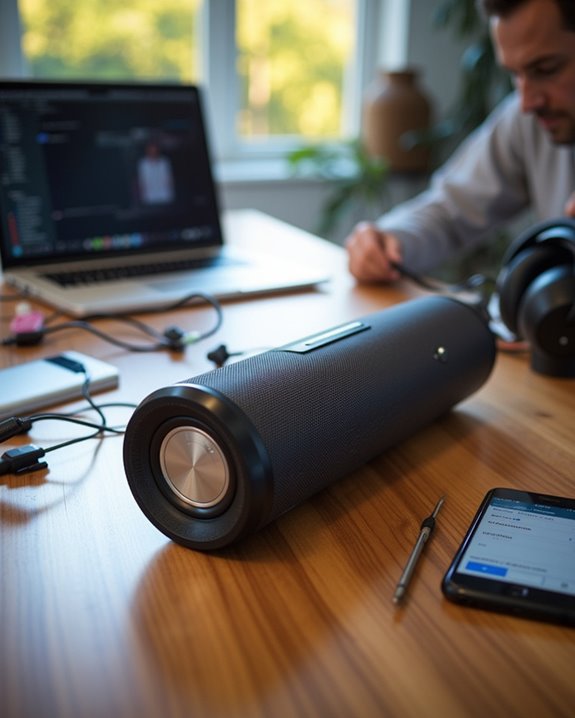To remove water from an iPhone, users must immediately power down the device, disconnect all accessories, and extract the SIM card. The next steps involve gently drying external surfaces with a lint-free cloth, positioning the device at a 45-degree angle to drain excess moisture, and utilizing desiccants like silica gel for 72 hours of absorption. Professional assessment becomes necessary if functionality issues persist. Proper technique and timing during these critical steps determine the likelihood of successful water damage recovery.
Key Takeaways
- Power off your iPhone immediately and remove all accessories, including the case and SIM card, to prevent electrical damage.
- Gently dry external surfaces with a lint-free cloth and tilt the device downward to help water exit through ports.
- Place your iPhone in a sealed container with silica gel packets or desiccants for superior moisture absorption.
- Keep the device in a well-ventilated area at room temperature for at least 72 hours, avoiding heat sources.
- Test basic functions after complete drying and check Liquid Contact Indicators before attempting to charge or update.
Act Fast: First Critical Moments After Water Exposure
When an iPhone comes into contact with water, taking immediate action within the first few minutes is essential for preventing permanent damage. Swift intervention begins with a thorough immediate evaluation of the device’s condition and removal of all external components.
Users should promptly disconnect any charging cables or accessories to prevent electrical shorts, and carefully remove protective cases that could trap water against the device. For applicable models, removing the SIM card helps prevent water from penetrating deeper into the device. The next critical step involves gently patting the iPhone dry with lint-free materials, being careful not to apply excessive pressure that could force water into internal components. This methodical approach to initial water exposure management greatly improves the chances of successful recovery and minimizes potential long-term damage to the device. Additionally, utilizing water-resistant technology can provide extra protection in water-prone environments.
Power Down and Disconnect Everything
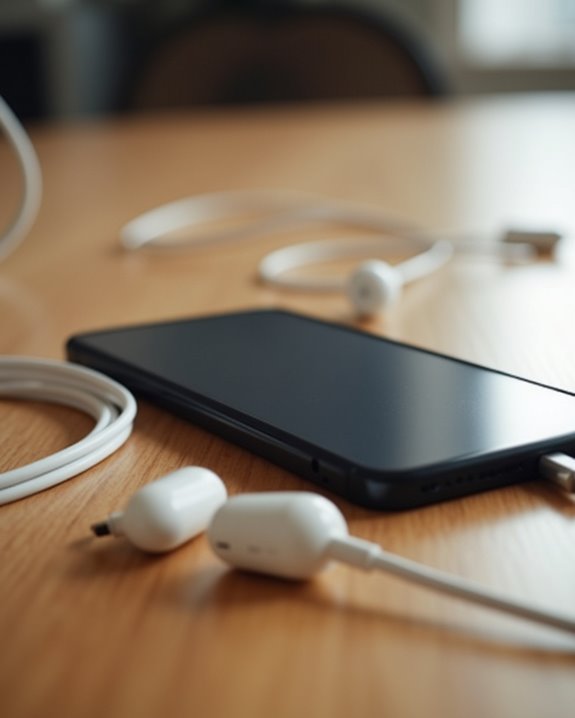
When confronted with a water-exposed iPhone, maintaining composure while taking immediate action is essential for preventing permanent damage. Users should systematically inspect the battery contacts first, as these metal components are particularly vulnerable to water-induced corrosion and electrical shorts. The combination of swift response time and methodical assessment of critical components greatly increases the likelihood of successful water damage mitigation.
Act Fast, Stay Calm
Quick, decisive action following water exposure can mean the difference between saving an iPhone and permanent damage. Swift reaction is vital – users must immediately remove the device from water, power it down completely, and disconnect all accessories to prevent electrical damage. The SIM card should be removed promptly to create better drying conditions.
Panic avoidance is essential during this critical period. Users should resist common impulses like using heat sources or shaking the device vigorously, as these actions can force water deeper into the components. Instead, the recommended approach involves gently patting the exterior with a lint-free cloth and placing the device in a well-ventilated area. Utilizing desiccants, such as silica gel packets, can effectively absorb residual moisture while maintaining ideal drying conditions.
Check Battery Contacts First
Protecting an iPhone’s internal components begins with a methodical inspection of the battery contacts and power system. For ideal Battery Safety, users must immediately power down the device and carefully disconnect the battery using appropriate tools to prevent circuit damage. The process requires removing screws with precision screwdrivers and examining all connector points for signs of corrosion or moisture accumulation.
Proper Connector Care involves using a clean, lint-free cloth or cotton swab to dry the contact points thoroughly, while inspecting for any water-induced damage. Technicians recommend avoiding metal tools that could scratch or compromise the connectors’ integrity. A detailed assessment of the battery contact area helps identify potential short circuits, oxidation, or other complications that could affect the device’s functionality once power is restored.
Remove Excess Water Safely
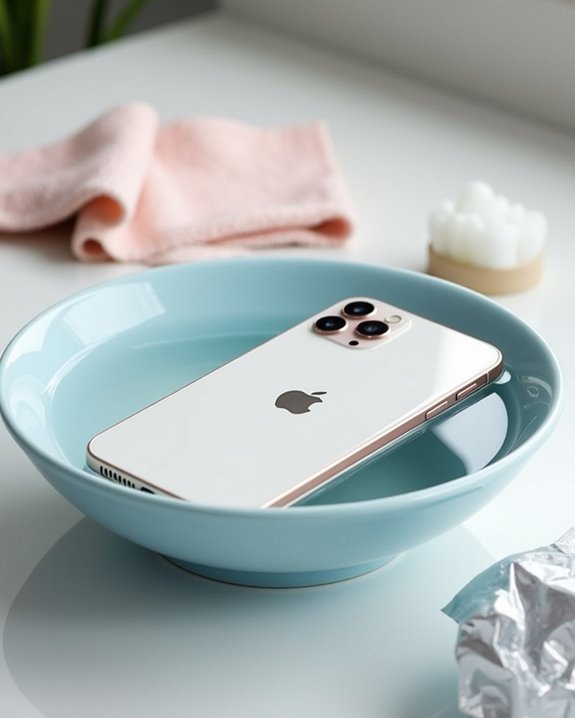
When faced with a water-exposed iPhone, users should first power down the device immediately to prevent potential short circuits, then carefully tilt and gently shake the device with the ports facing downward to allow gravity to assist with water removal. Using a clean, lint-free microfiber cloth, thoroughly wipe all external surfaces to remove visible moisture, paying special attention to ports, speaker grilles, and button crevices. The combination of careful physical manipulation and proper drying techniques helps minimize water damage while preserving the device’s internal components.
Shake Out Liquid Carefully
Removing water from an iPhone requires a careful and methodical approach, beginning with a controlled shaking motion to dislodge excess liquid. Users should position the device with the affected area facing downward, allowing gravity to assist in water extraction while maintaining gentle shaking movements that won’t compromise internal components.
For best results, the orientation tips suggest holding the iPhone at a 45-degree angle during the gentle shaking process, ensuring water follows a natural path toward the device’s openings. This technique proves most effective when implemented immediately after water exposure, before liquid has time to penetrate deeper into the device. Users must exercise restraint during this process, as excessive force can drive water further into sensitive electronic components, potentially causing additional damage to the iPhone’s internal circuitry.
Wipe External Surfaces Clean
Gently wiping an iPhone’s external surfaces represents a critical step in preventing water damage, requiring precise techniques and appropriate materials to safely remove moisture. iPhone users should employ proper Microfiber Care techniques, utilizing lint-free cloths that effectively absorb liquid while preventing microscopic scratches on sensitive surfaces.
For ideal Water Dampening procedures, technicians recommend slightly moistening the microfiber cloth with distilled water when necessary to remove stubborn residue. Users should avoid abrasive materials like paper towels, which can deposit harmful particles in ports and compromise protective coatings. The recommended technique involves working from the top downward, particularly around speakers and ports where moisture commonly accumulates. This methodical approach guarantees thorough cleaning while preventing liquid from seeping into internal components through display edges or port openings.
Power Down Immediately
Swift power-down procedures represent the most crucial initial response when an iPhone encounters water exposure, requiring immediate action to prevent catastrophic internal damage. The Emergency Powerdown protocol must be initiated by pressing and holding the power button until the “slide to power off” prompt appears, followed by an Instant Shutdown.
During this critical phase, users should avoid pressing any other buttons or controls, as additional interaction may force water deeper into the device’s components. The complete deactivation of electrical systems prevents potential short circuits and minimizes the risk of permanent damage to sensitive internal circuitry. This protective measure guarantees that electrical current cannot flow through moisture-compromised components, greatly improving the chances of successful recovery. The power-down sequence must be executed promptly, as every second counts in preventing irreversible water damage.
Choose the Right Drying Method
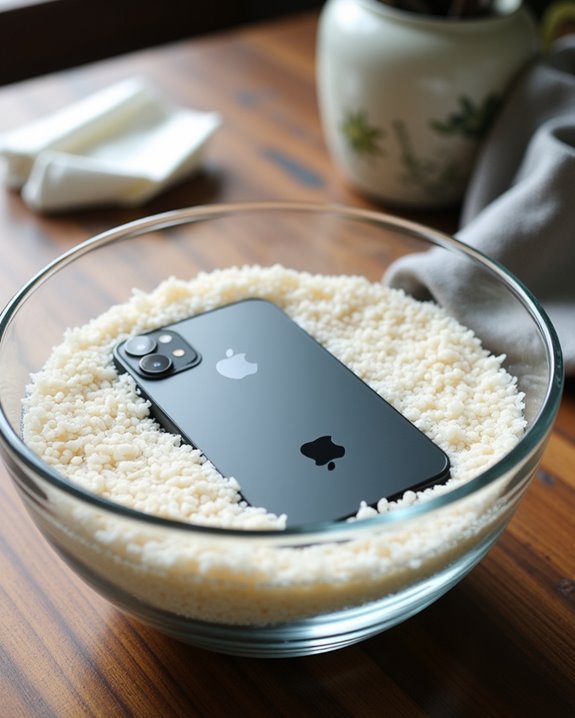
When water infiltrates an iPhone, selecting an appropriate drying method becomes essential for preventing permanent damage to internal components. Among desiccant options, silica gel beads emerge as the most effective solution, offering superior moisture absorption without leaving problematic residue. While instant rice and couscous present viable method alternatives, users should avoid traditional uncooked white rice due to its tendency to introduce starch particles into device ports.
For best results, place the device in a sealed container with the chosen desiccant, ensuring maximum contact between the drying agent and iPhone surfaces. Position the container in a room-temperature environment with natural airflow, and maintain these conditions for a minimum of 72 hours. A cool-air fan directed at the connector port can accelerate moisture displacement without risking component damage.
Monitor Recovery and Check Components
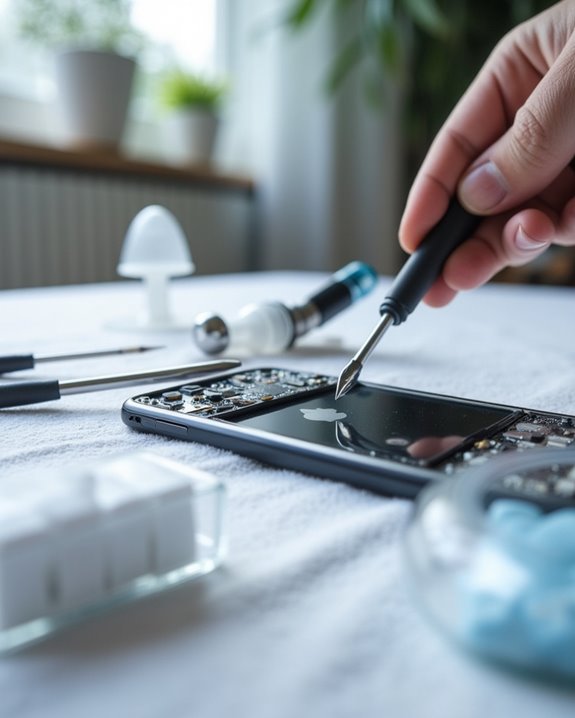
Careful monitoring of an iPhone’s recovery process after water exposure requires systematic evaluation of multiple components and indicators to assess the likelihood of successful restoration. Recovery monitoring begins with checking the Liquid Contact Indicators (LCIs), which change color upon water exposure, typically visible in the SIM card slot or charging port.
Component analysis involves inspecting visible parts for corrosion, particularly on the logic board, while watching for warning signs like unusual odors or sounds. After a 48-hour drying period, users should test basic functionality including calling, texting, and internet connectivity. If the device shows signs of malfunction, professional assistance may be necessary. Regular post-recovery checks and performance monitoring help identify potential issues early, while maintaining preventive measures such as waterproof cases can protect against future incidents.
Test Device Functions Systematically
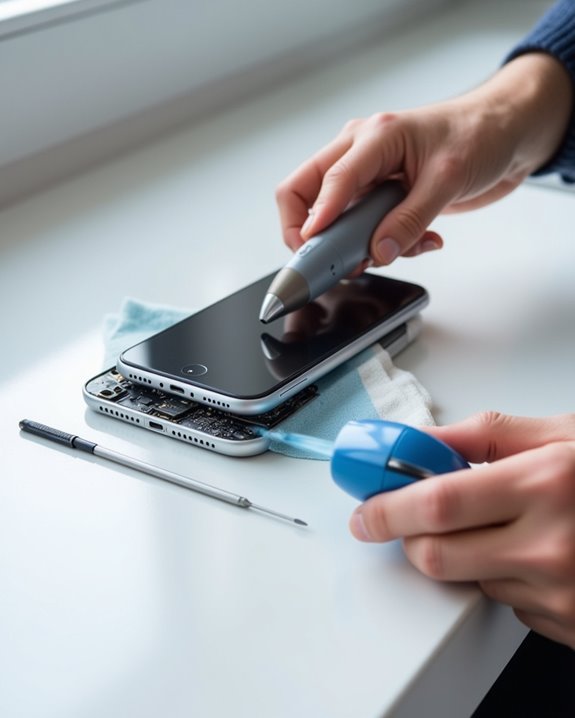
Systematic testing of an iPhone’s functions after water exposure requires a structured approach focused on verifying core device capabilities. Users should conduct advanced diagnostics by methodically examining each component, starting with power systems and progressing through connectivity features. It is also advisable to consult water-resistant ratings and how they influence testing procedures. The testing sequence begins with basic power verification, followed by port inspections and wireless functions. Critical assessments include checking the device’s charging capabilities, audio output, and touch response. After confirming these fundamentals, users should evaluate camera systems, sensors, and buttons while monitoring for any anomalies. Before attempting firmware updates, it’s crucial to verify that all Liquid Contact Indicators (LCIs) show no signs of activation. This thorough evaluation confirms all critical functions are operational and helps identify any components requiring professional attention.
Professional Help and Long-Term Care
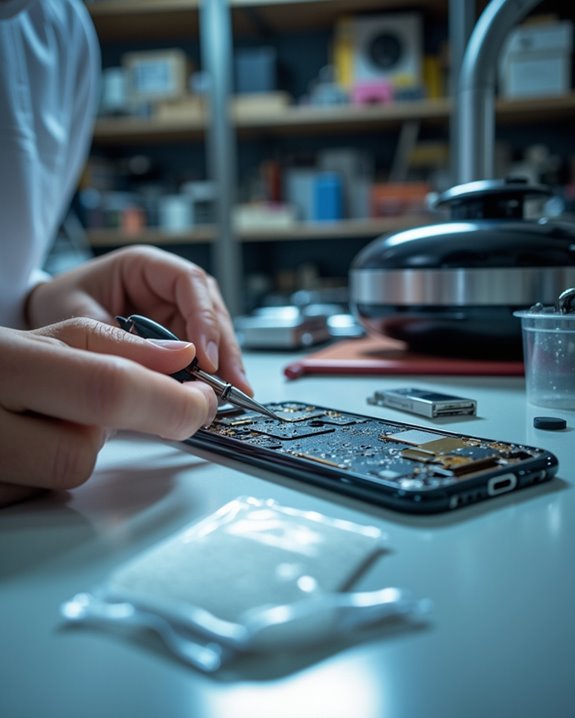
Professional repair services offer essential intervention options for water-damaged iPhones, with specialized technicians possessing the expertise and equipment necessary for thorough device restoration. Independent Repair Providers and Apple-authorized centers utilize advanced diagnostic tools, ultrasonic cleaning methods, and corrosion mitigation techniques to address internal damage effectively. When considering repair options, owners should evaluate warranty options and insurance claims carefully. AppleCare+ covers up to two accidental damage incidents annually, while third-party warranties from certified providers typically range from 3-12 months on parts and labor. Post-repair maintenance strategies include using desiccant storage, applying nano-coating protection, and implementing proper charging habits to prevent future complications. Regular diagnostic checks and humidity monitoring can help detect potential issues before they escalate into significant problems. Additionally, selecting waterproof accessories or cases can provide extra water resistance and help prevent future water damage.
Frequently Asked Questions
How Long Does Water Damage Take to Show up in Iphones?
While some water damage appears instantly through shorts or screen issues, damage latency varies greatly. Symptom onset can emerge immediately or develop over weeks through corrosion, affecting charging ports and internal components.
Can Salt Water Cause More Damage Than Fresh Water?
Yes, salt water effects are greatly more damaging than freshwater. The electrolytes in saltwater accelerate corrosion differences, leaving harmful crystal deposits and aggressively degrading internal components through chemical reactions, even after the device appears dry.
Will My Iphone Warranty Cover Accidental Water Damage?
Like a fish out of water, standard iPhone warranties exclude liquid damage claims. For peace of mind, AppleCare+ members can file claims with a $99 deductible, while everyone else faces warranty exclusions for water exposure.
Can I Use Compressed Air to Dry Out My Iphone?
Using compressed air to dry an iPhone is not recommended. Despite common myths, air safety concerns include potential damage to internal components and coatings. Members of the iPhone community should avoid this risky drying method.
Is It Safe to Put My Iphone in Direct Sunlight?
Direct sunlight exposure is not safe for iPhones. UV protection is essential as sunlight can cause overheating, battery damage, and system malfunctions. Like most electronics, iPhones require protection from extreme heat for ideal performance.

